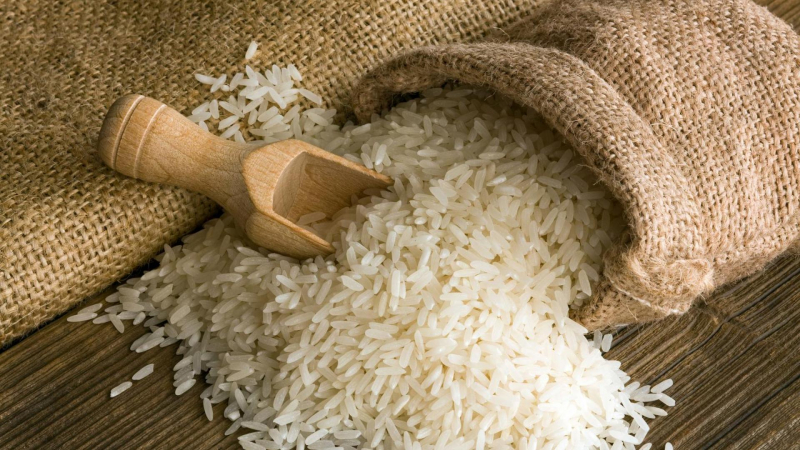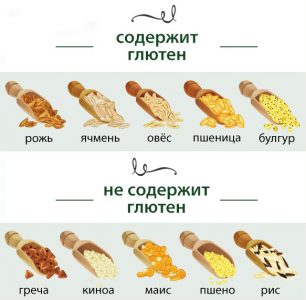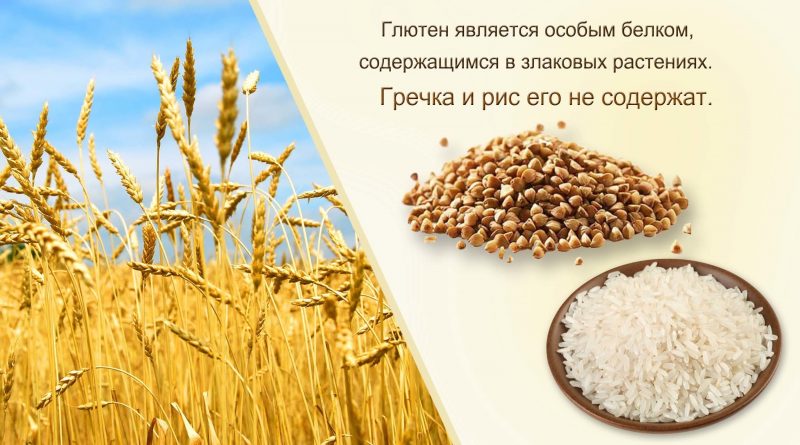Beware of gluten: is it in rice?
Today, the word "gluten" is increasingly used in a negative context. Nutritionists are recommending a gluten-free diet, and the number of products labeled "gluten-free" on store shelves is skyrocketing. However, it is found in a third of all foods consumed by humans, including the cereals we eat daily.
Let's figure out what gluten is, whether it is in red and white rice, buckwheat, corn and what are the consequences of their use.
The content of the article
Chemical composition, trace elements and beneficial properties of rice

Rice porridge ranks second in terms of production worldwide. The chemical composition of rice differs depending on the cultivar, area and growing conditions.
On average, dry, uncooked cereals contain:
- 68% starch;
- 7-10% nitrogen;
- 1.8-2.5 fat;
- 10-12% fiber;
- 2-3% pentosans;
- 1.5-2.5 sugar;
- 5-6% minerals;
- 360 kcal;
- 0.58 g fat;
- 6.61 g of proteins;
- 79.34 g carbohydrates;
- 12.89 g water;
- 0.58 g of ash.
Macro- and microelements that make up 100 g of rice:
- calcium - 0.9%;
- magnesium - 8.8%;
- iron - 8%;
- phosphorus - 15.4%;
- potassium - 1.8%;
- sodium - 0.1%;
- zinc - 10.5%;
- copper - 12.2%;
- manganese - 47.8%.
Rice is also rich in B vitamins:
- B1 - 5.8%;
- B2 - 3.7%;
- B3 - 10%;
- B5 - 26.8%;
- B6 - 11.2%;
- B9 - 2.3%.
Rice has a number of useful properties:
- has a beneficial effect on the nervous system;
- reduces the risk of cancer;
- improves brain function;
- supports the work of the cardiovascular system;
- normalizes the activity of the digestive tract;
- improves the appearance of skin, nails and hair;
- energizes;
- slows down the aging process of the body.
What foods contain gluten

Buckwheat does not contain gluten (gluten), so it is safely recommended to be consumed not only by adults, but also by very young children. This cereal is the most nutritious, it is rich in proteins, B vitamins, iron, zinc, potassium, magnesium, copper.
Corn porridge, like buckwheat, does not contain gluten. But it contains a lot of vitamin E and iron, and starch is also present in it.
Does rice contain gluten
White rice is most common in cooking. It contains a lot of starch, but not enough vitamins and minerals, which is associated with the deep processing of grain. It does not contain gluten.
Brown rice undergoes minimal processing, therefore it is considered the most useful. Due to this, many nutrients and vitamins remain in it. It also lacks gluten.
Red rice is known for its nutty flavor and health benefits. It is also gluten free.
Thus, the gluten content of any rice is zero.

Why is gluten harmful and what is the benefit of it?
Gluten has several beneficial properties:
- participates in tissue regeneration;
- strengthens the immune system and bone tissue;
- normalizes hemoglobin levels;
- helps the body recover from injuries and operations;
- saturates the body with vitamins and minerals.
The harmful effects of gluten on the body are associated with the risk of:
- allergic reactions and intolerance;
- intoxication;
- functional disorders of the digestive tract;
- inflammatory diseases of the stomach and intestines.
Why celiac disease is dangerous
A disease characterized by gluten intolerance is called celiac disease... It is a digestive disorder in the small intestine that results from an autoimmune reaction to gluten.
The small intestine is lined with tiny villi that aid in the absorption of protein and fat.In people with celiac disease, these villi are damaged, resulting in impaired absorption of nutrients and upset digestion.
According to statistics, about 1% of the population suffers from celiac disease in the world. Previously, it was mistakenly believed that this disease is inherent in children, but recent studies have shown that adults also suffer from gluten intolerance.
This is a very serious condition, and if left untreated, problems with the thyroid gland and bones will develop over time. In addition, celiac disease increases the risk of developing cancer.
Gluten Intolerance Symptoms:
- bloating;
- diarrhea;
- weight loss;
- headache;
- anemia;
- rash on the skin;
- fast fatigability, etc.
What experts say about gluten
Gluten is a gummy protein that comes in a powder form. It is found mainly in cereals such as rye, wheat and barley.
Contrary to popular belief, gluten is not the only substance. It combines two proteins:
- gliadin, which makes gluten elastic;
- glutenin, which gives it strength.
Gluten is called gluten because, when diluted with water, it forms a thick, sticky mass. Due to this, it has become so popular in the food industry, especially in the preparation of baked goods and meat dishes. They last longer thanks to gluten are kept, do not lose their shape and have an airy consistency when baked.
Gluten is a part of bakery products, sweets, ice cream, dairy products, sausages, various semi-finished products, mayonnaise, ketchup, and cereal-based drinks (beer, vodka, whiskey).

Gluten-free foods are vegetables, fruits, poultry, seafood, and cereals. There is no gluten in rice, buckwheat, corn.
Attention! For people who do not have celiac disease, the use of gluten is allowed, and in reasonable quantities it is even recommended. For example, wheat contains gluten, and this cereal is a storehouse of many vitamins and nutrients, so you cannot completely abandon it.
Determining if a product contains gluten is easy. You just need to look at the label.
Gluten is hiding under these names:
- textured vegetable protein;
- modified food starch;
- hydrolyzed vegetable protein.
How to know if you have a gluten intolerance
Gluten intolerance is most commonly transmitted genetically... If one of the relatives suffered from this disease, the risk of getting sick increases significantly.
Intolerance develops, as a rule, under the influence of stressful situations: operations, viral infections, pregnancy, etc. About 80% of people with celiac disease do not know about their illness.
You can find out if you have a gluten intolerance at home. To do this, eliminate all gluten-containing foods from your diet and follow this diet for about two weeks. Then go back to your usual diet. From the symptoms that appear, it will be clear whether there is gluten intolerance or not.
However, it is very difficult to diagnose celiac disease on your own, since the symptoms of this disease are nonspecific and can indicate completely different problems.
To check for celiac disease, a blood test for specific antibodies is done and an endoscopy with a biopsy of the affected intestine is done.
Conclusion
Rice, buckwheat and corn cereals do not contain gluten, so they are allowed to be consumed not only by adults, but also by children.
It is very difficult to avoid gluten in the modern world. It is found in sweets, bread, dairy products, sausages, and some cereals. Therefore, if the symptoms indicated above are observed, do not self-medicate, but consult a specialist.